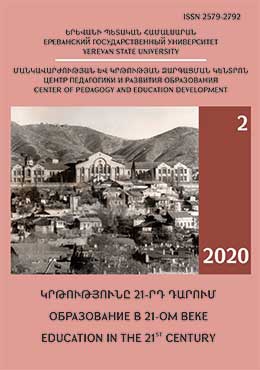ANALYSIS OF INPUT INDICATORS OF THE SPHERE OF HIGHER EDUCATION OF KAZAKHSTAN
DOI:
https://doi.org/10.46991/educ-21st-century.v2i4.10964Keywords:
Higher education, education management, EAEU member states, the education system of Kazakhstan, input indicators, education development.Abstract
The temporal and spatial distribution of the current challenges in the field of higher education
management shows that these same challenges can be solved through joint efforts that do not
contradict international trends in the development of the education sector. The effectiveness of the
search for common solutions in the field of education has been proven over the course of a decade,
as it also becomes clear that spatial, economic, political, cultural and other factors can be the basis
of unity. It is this complex of factors that underlies the formation of the EAEU. Cooperation of the
EAEU member states in the field of education has new prospects - not all aspects of this
cooperation have been identified and are operating in the current period.
Of particular importance is the study of the educational traditions of societies representing
different cultures of the EAEU member states, the contours of new dialogues. From this point of
view, it is especially important not only to study the Russian education sector, which is completely
open for cooperation in the Armenian education sector, but also to study the Kazakhstani
education experience, which is possible in terms of identifying new educational and cultural
interactions.
Cooperation between the EAEU member states has not yet achieved final success in the field
of education, which requires new research.
If the volume of cooperation between Armenia and Russia, the underlying factors and
perspectives are clearer, the same is difficult to say about Kazakhstan. As EAEU member states,
apart from examples of private cooperation in the field of education, the ways of cooperation in the
field of higher education management have not been expanded and clarified, especially between
Kazakhstan and Armenia.
This study aims to facilitate the search for cooperation in the field of education management
in the EAEU member states.
218
The purpose of the study is to identify the specifics of the indicators of the input of
Kazakhstani higher education from the EAEU member states using a specially developed
methodology.
As part of the study, a new methodology for the comparative analysis of the higher education
systems of the EAEU member states was developed, within the framework of which indicators
were developed for the first time, thanks to which it is possible to evaluate and analyze the features
of education management.
References
Ժողովրդավարության մակարդակի ինդեքսի համեմատական վերլուծություն.
Հայաստան, Վրաստան, Ադրբեջան, Բելառուս, Ղազախստան, Ուկրաինա, Մոլդովա:
Խմբ. Ա. Ալեքսանյան, ԵՊՀ հրատ., Երևան, 2015:
Модернизация системы высшего образования Армении в контексте интеграцион-
ных процессов. // Монография. Под редакцией Аветисяна П. С., Заславской М. И., Изда-
тельство РАУ, 2017.
Университеты в евразийском образовательном пространстве/ ред. кол.:
Садовничий В. А., М.: Изд.-во Московского университета; Макс пресс, 2017, 392 с.
Human Development Data (1990-2018) http://hdr.undp.org/en/data (10.04.2020).
The European Higher Education Area: Between Crtitical Reflections and Future Policies.
Edited by Curaj A., Liviu M. and others, Part 1 and Part 2, Springer Open, 2015.
Downloads
Published
How to Cite
Issue
Section
License

This work is licensed under a Creative Commons Attribution-NonCommercial 4.0 International License.

